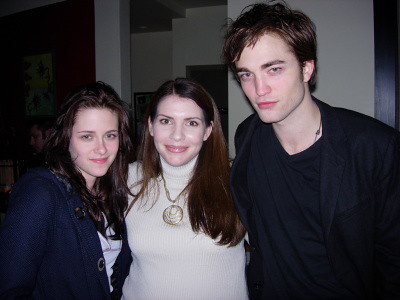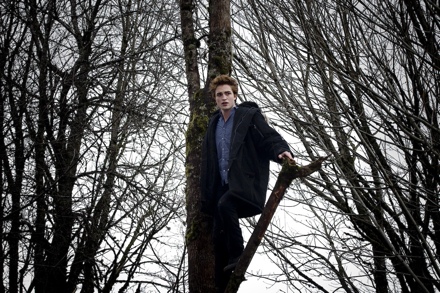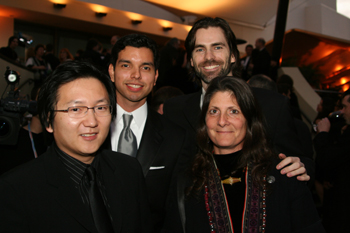A post-supervisor profile from the latest print issue of BTL…
Writers, of course, don’t have to worry about effects budgets — or even existing digital technology. Except, perhaps, for the Amazon Kindle. At least, if you’re an author of books. But then again, if you’re one of those anointed scribes whose book becomes a movie — and a hit movie at that — you not only don’t have to worry Amazon Kindles (you’re already a fast moving download there), but you don’t have to worry about filmic digits, either. That’s someone else’s job.
So it is for Stephenie Meyer, author of the mega-selling “Twilight” series, about dewey young, almost-sexual vampires. But not too sexual. Her first book has been brought famously to the screen, by director Catherine Hardwicke, and — like the books themselves — has worked its way to sleeper hit status.

So, when Meyer described her I-was-a-teenage-vampire as “sparkling as if encrusted by diamonds, yet smooth like marble,” as recalled by special effects supervisor Richard Kidd, well, it became his job to figure out how that looked on screen.
And yet, “if you literally created that” on screen, he notes, you’d be “conflicting, visually.” Mainly because the very reason that diamonds “glitter” is because they’re multi-faceted, reflecting light from numerous surfaces. Not smooth at all. “If you try to do it as written, it just doesn’t work.”
In fact, Kidd and company did try to approximate the written description, using red and yellow hues all over the putative bejeweled-yet-alabaster skin of the bloodsuckers, particularly main bloodsucker/heartthrob Edward Cullen — as essayed by actor Robert Pattinson — winding up with an effect that “looked like he had acne or inflamed skin.”
And we know how particular vampires are about their looks.

Luckily, director Hardwicke was working in more of a blue/silver palette, so to meet this “design challenge,” — Kidd also observes that regardless of the color scheme, there was the danger of hitting a tipping point of a too much digital “bling — we didn’t want him looking like a disco ball.” The much-sought sparkling epidermis was finally achieved with a mix of tools, an “artistic melding” of techniques and software packages, including Maya, Photoshop, Shake, with shots — not just the vaunted blue skin — being apportioned between several post houses, including Vancouver-based CIS, Kidd’s own Catalyst Media, Gentle Giant studios, Rez-Illusion, even a handful of scenes given to ILM — among others, all of whom worked on what was, for Kidd, an unusually tight schedule.

The film, which began shooting last fall — Kidd himself use some previz, but it wasn’t “too valuable for Catherine,” who prefers a more “documentary” approach — needed to to wrapped, post and all, in early September. Yet they didn’t get final approval of a shot list until August, and didn’t finish, in spite of a “lean mean” approach that Kidd says taught him much, until the beginning of November. Which is, appropriately, the Day of the Dead.
However, the melding of the tight deadlines and Hardwicke’s preference for doc-style directing — her previous efforts included the skate-themed 70’s opus “The Lords of Dogtown,” and coming-of-age tale “Thirteen” — meant that a lot of what looked like digits actually wound up being practical effects.
Not only the schedule, but “the budget was pretty tight for us,” Kidd recounts. “We needed to capture as much as we could on camera.” That meant a lot of “wire work,” just like the Hong Kong cinema. Some of the film’s more notable sequences — a “showdown” in a ballet studio, a fight among the treetops — were in fact done largely with wires, and other innovations, like a plexiglass “magic carpet” on which vampire actors could ride, and appear to fly.
There was also a lot of smokey atmosphere in these sequences, which violated what Kidd calls “CG 101 — don’t try to paint out wires in smoke.”

Yet that was exactly his task, resulting in what he describes as “clean-up (that) was non-trivial.” And not only because of the smoke: The aboreal imbroglio required “painstaking” work, because there is so much detailed background — each branch of each real tree — to tend to, which notching out wires and cabling equipment. Additionally, not only actors, but cameras were rigged to fly around, too.
Still, the approach Kidd took was to let her “shoot her movie,” without having to think about leaving room for digits. And while she worked in conjunction with director of photography Elliot Davis, Kidd did some photography of his own, capturing high-res gigapixel imagery of the various locations. The panoramas were for various “just in case” scenarios — including filling in backgrounds or augmenting matte paintings.

That kind of contingency planning was “probably the stuff I learned the most about,” Kidd says of his time on “Twilight.” And while he won’t be supervising FX on the sequel — having moved to another job (as has Hardwicke), that learning may be no accident. After all, the story’s not just about vampires — it’s set in a school, too.





